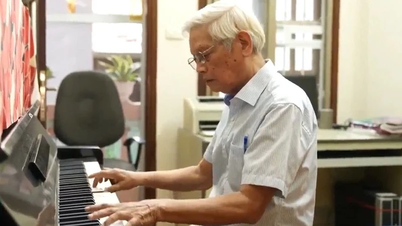
Patients at some hospitals in Ho Chi Minh City still use medical records when going for medical examinations.
In less than three months, hospitals across the country must "kill" paper medical records and complete electronic medical records as required by the Ministry of Health . In reality, many hospitals are still using paper medical records while struggling to deploy electronic medical records software.
Patients still have to use medical records.
In Ho Chi Minh City, many hospitals have successfully deployed electronic medical records such as the City Children's Hospital, Nguyen Tri Phuong Hospital, Hung Vuong Hospital, Gia Dinh People's Hospital, Le Van Thinh Hospital...
According to Tuoi Tre , at many hospitals in Ho Chi Minh City, patients still use medical records when visiting the hospital. This causes a lot of inconvenience, wasting time and money for patients.
In parallel with treating and monitoring the patient's health, medical staff also spend time recording the disease progression and the medications, infusions, consumables... that the patient used during treatment in the medical record.
Each patient has a medical record. The longer a patient stays in the hospital, the thicker the medical record. However, all patient information is done manually. This is both time-consuming and labor-intensive, and requires a large space to store medical records.
On the morning of July 7, at a district hospital in Ho Chi Minh City, many people coming for examination and treatment still had to bring their medical records to areas and departments in the hospital to be examined.
Many elderly people with chronic diseases who need regular check-ups carry their medical records with them, some of them holding up to three different medical records.
A typical case is Mrs. DP (67 years old, Ho Chi Minh City). She said that she has had high blood pressure and heart disease for many years, so she has to go to the hospital for monthly check-ups. After each check-up, the doctor will staple a prescription into her medical record book.
When the pages in the medical record book are full, she is forced to buy a new medical record book at 5,000 VND/book.
"I had brought some notebooks before, but I'm old and keep forgetting them. I couldn't find them, so I had to go to the hospital to buy new notebooks. Today, I was able to find three, so I brought them to show the doctor. I have to read a lot of documents carefully when I go to the doctor's office, which is very inconvenient," Ms. P. complained.
Speaking with Tuoi Tre , a representative of the Central Hospital of Odonto-Stomatology in Ho Chi Minh City said that although the unit has applied the medical information management system for a long time, it has not yet met the standards to announce the implementation of electronic medical records due to a lack of necessary technical and legal conditions.
Explaining the reason, he said that the current information technology systems of many hospitals are old and do not have the capacity to handle the increasing amount of data. The system is also weak in connecting with external platforms.
Meanwhile, the IT team is not up to the task and lacks medical experience, making it difficult to keep up with the implementation progress. On the other hand, many older doctors are not used to reading documents on computers, they mainly read printed documents. Therefore, this habit must be changed to apply the digitalization process.
Up to now, this hospital is upgrading the entire system, and at the same time building its own application integrated with electronic medical records, striving to complete it on time before September 30 as prescribed.
Dr. Nguyen The Vu, Director of District 7 Hospital (HCMC), said that the hospital is currently accelerating the completion of electronic medical records and quickly applying them throughout the hospital. According to the plan, by mid-July 2025, the hospital will deploy electronic medical records throughout the hospital, and by August 2025, it will be evaluated.

A patient must bring all 3 old medical records so that the doctor can easily track them when going to the hospital for examination - Photo: THU HIEN
A breakthrough "push"
The Ministry of Health has issued a roadmap requiring units to quickly deploy electronic medical records by September 30. Accordingly, it requires medical examination and treatment facilities licensed to operate as hospitals to deploy electronic medical records by September 30.
For other medical examination and treatment facilities with inpatients, day care and outpatients, deploy electronic medical records, to be completed no later than December 31, 2026.
As one of the few hospitals in Ho Chi Minh City to successfully implement the electronic medical record model since 2024, the City Children's Hospital believes that this is a breakthrough "push" in the field of smart healthcare of the hospital.
Mr. Truong Quang Dinh, director of the City Children's Hospital, said that electronic medical records are part of the digital transformation process, replacing conventional handwritten medical records. All medical records, prescriptions, instructions, test results... at the hospital are recorded using a digital system in the electronic medical record data.
This helps doctors get the fastest and most accurate information to be able to make timely intervention decisions.
Because this hospital specializes in examining and treating children, the hospital's electronic medical records have their own characteristics, ensuring accuracy and continuity from the time the child is born through each stage of development.
In addition, electronic medical records must be deployed so that parents can easily use them and track their children's medical examination, treatment, and vaccination history.
According to Mr. Nguyen Tran Nam, Deputy Director of the City Children's Hospital, the most important thing that electronic medical records bring is to limit errors, thereby helping to save costs and ensure patient safety.
As for managers, electronic medical records help monitor the status of drugs, supplies, equipment... at the hospital, thereby having an effective management plan, bringing more economic benefits.
Speaking with Tuoi Tre , Mr. Hoang Van Tien, deputy head of the Department of Solutions and Quality Management of the National Center for Health Information (Ministry of Health), said that up to now, the unit has issued many guiding documents for hospitals when implementing electronic medical records.
Top priority task
Mr. Tang Chi Thuong, Director of the Ho Chi Minh City Department of Health, also asked hospital directors to clearly understand that this is a top priority task and that all resources need to be focused to complete it in the context of the strong digitalization era.
Delays in digital transformation, especially electronic medical records, will seriously affect the performance, effectiveness and efficiency of the entire industry.
To support hospitals in the digital transformation process, especially in information technology infrastructure, the Ho Chi Minh City People's Committee has agreed to invest a significant amount of budget. Second-level hospitals will be granted VND20 billion, while first-level hospitals will receive VND40 billion to strengthen infrastructure and ensure network security.
Patient information must be kept confidential.
The Ministry of Health said that when put into use, electronic medical records will manage personal information, medical examination results, paraclinical tests, functional tests; the process of diagnosis, treatment, care and other relevant information during the treatment process at medical examination and treatment facilities.
Each patient will have a unique identification code based on the personal identification number to connect and communicate electronic medical record data.
When transferring patient information to the network environment, the risk of leakage is very high, if we are not vigilant and do not have solutions to ensure information security.
Therefore, the Ministry of Health recommends that medical examination and treatment facilities pay attention to implementing many groups of technological solutions to ensure patient information security such as firewalls, anti-virus software... to prevent external attacks on the unit's information system.
Source: https://tuoitre.vn/khai-tu-benh-an-giay-co-dung-hen-20250708231259942.htm



![[Photo] General Secretary receives heads of political party delegations from countries attending the 80th anniversary of our country's National Day](https://vphoto.vietnam.vn/thumb/1200x675/vietnam/resource/IMAGE/2025/9/1/ad0cb56026294afcae85480562c2e790)
![[Photo] People eagerly wait all night for the parade on the morning of September 2](https://vphoto.vietnam.vn/thumb/1200x675/vietnam/resource/IMAGE/2025/9/1/0cf8423e8a4e454094f0bace35c9a392)
![[Photo] National Assembly Chairman Tran Thanh Man receives Cambodian Senate President Hun Sen](https://vphoto.vietnam.vn/thumb/1200x675/vietnam/resource/IMAGE/2025/9/1/7a90c9b1c1484321bbb0fadceef6559b)
![[Photo] Chu Dau Ceramics – Proud of Vietnamese identity at Exhibition A80](https://vphoto.vietnam.vn/thumb/1200x675/vietnam/resource/IMAGE/2025/9/1/c62ab2fc69664657b3f03bea2c59c90e)
![[Photo] Solemn reception to celebrate the 80th anniversary of the National Day of the Socialist Republic of Vietnam](https://vphoto.vietnam.vn/thumb/1200x675/vietnam/resource/IMAGE/2025/9/1/e86d78396477453cbfab255db1e2bdb1)
![[Photo] Celebration of the 65th Anniversary of the Establishment of Diplomatic Relations between Vietnam and Cuba](https://vphoto.vietnam.vn/thumb/1200x675/vietnam/resource/IMAGE/2025/9/1/0ed159f3f19344e497ab652956b15cca)































































































Comment (0)